 HP unveiled a third generation of StoreOnce devices targeted at improving backup and restore performance, StoreOnce redundancy and introducing a new interface to handle backups. The new StoreOnce B6200 was introduced last week at HP Discover. With the new B6200, customers will get a 2-node base configuration configured as a couplet (cluster) with seamless failover in case a single node fails. The B6200 can scale up to 4 couplets or 8 nodes in total with 768TB of raw storage (512TB usable). But the real magic of the new architecture if what customers will receive — improved speeds.
HP unveiled a third generation of StoreOnce devices targeted at improving backup and restore performance, StoreOnce redundancy and introducing a new interface to handle backups. The new StoreOnce B6200 was introduced last week at HP Discover. With the new B6200, customers will get a 2-node base configuration configured as a couplet (cluster) with seamless failover in case a single node fails. The B6200 can scale up to 4 couplets or 8 nodes in total with 768TB of raw storage (512TB usable). But the real magic of the new architecture if what customers will receive — improved speeds.
Still based on the industry-leading Proliant architecture, the latest generation pushes for speed in backups and recovery. In native backup mode, the StoreOnce B6200 will achieve speeds of 40TB per hour in backup and in restore in VTL mode. HP Storage vice president David Scott was quick to point out that the competition’s D2D backup devices take a 50% hit on restores versus the native backup speeds. The latest generation of StoreOnce is architected to ensure there was no performance loss for restores, when enterprise is really counting on the speed.
In addition to the impressive speeds, the StoreOnce B6200 also includes HP’s StoreOnce Catalyst software, which will allow for an incredible 150% improvement on backups speeds using the new native API, which sees the D2D devices for exactly what it is, rather than emulating virtual tape libraries. HP showcased this new technology on the showroom floor during HP Discover, last week, equating the speed of backup that would allow a customer to backup the Library of Congress three times in a single night. And those, are pretty impressive numbers.
The configurations use 2TB SAS drives in the storage enclosures. Each couplet scales up to 192TB of raw storage and 128TB of usable storage. But best of all, when fully populated, all 4 couplets are managed as a single device.
For existing customers, I spoke with engineers on the showroom floor that say the Catalyst software will likely come to older StoreOnce devices, though there is not a timeline. The Catalyst version of StoreOnce OS is based on a standard Linux kernel as opposed to earlier StoreOnce OS distributions that were based on a customized Linux distribution. HP is expected to unify these releases in the future.
Disclosure: HP sponsored my trip to HP Discover, covering all travel expenses, however HP does not control the content of the posts that I write based on my attendance to the show. The thoughts, impressions and information contained in this post are my own.
